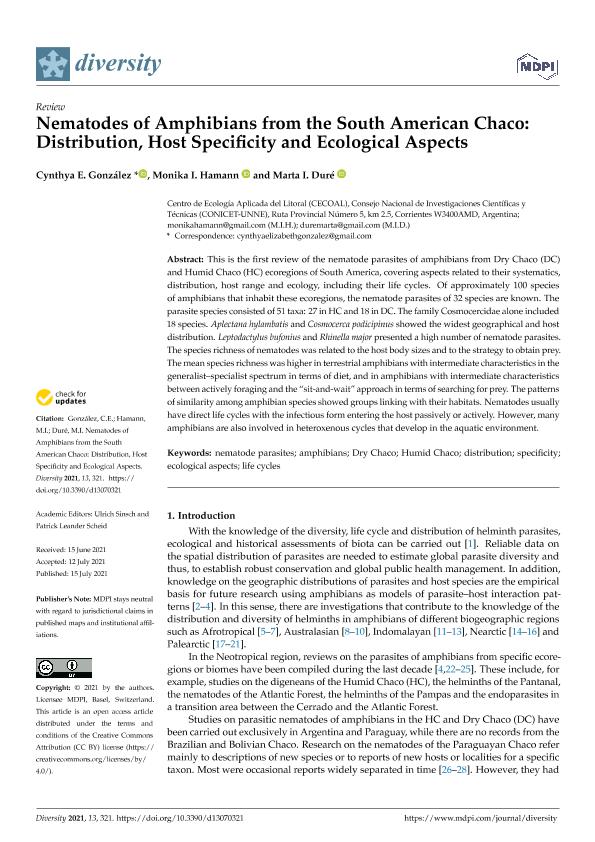Mostrar el registro sencillo del ítem
dc.contributor.author
Gonzalez, Cynthya Elizabeth

dc.contributor.author
Hamann, Mónika Inés

dc.contributor.author
Duré Pitteri, Marta Inés

dc.date.available
2023-01-02T17:53:06Z
dc.date.issued
2021-07
dc.identifier.citation
Gonzalez, Cynthya Elizabeth; Hamann, Mónika Inés; Duré Pitteri, Marta Inés; Nematodes of Amphibians from the South American Chaco: Distribution, Host Specificity and Ecological Aspects; MDPI; Diversity; 13; 7; 7-2021; 1-24
dc.identifier.issn
1424-2818
dc.identifier.uri
http://hdl.handle.net/11336/182945
dc.description.abstract
This is the first review of the nematode parasites of amphibians from Dry Chaco (DC) and Humid Chaco (HC) ecoregions of South America, covering aspects related to their systematics, distribution, host range and ecology, including their life cycles. Of approximately 100 species of amphibians that inhabit these ecoregions, the nematode parasites of 32 species are known. The parasite species consisted of 51 taxa: 27 in HC and 18 in DC. The family Cosmocercidae alone included 18 species. Aplectana hylambatis and Cosmocerca podicipinus showed the widest geographical and host distribution. Leptodactylus bufonius and Rhinella major presented a high number of nematode parasites. The species richness of nematodes was related to the host body sizes and to the strategy to obtain prey. The mean species richness was higher in terrestrial amphibians with intermediate characteristics in the generalist–specialist spectrum in terms of diet, and in amphibians with intermediate characteristics between actively foraging and the “sit-and-wait” approach in terms of searching for prey. The patterns of similarity among amphibian species showed groups linking with their habitats. Nematodes usually have direct life cycles with the infectious form entering the host passively or actively. However, many amphibians are also involved in heteroxenous cycles that develop in the aquatic environment.
dc.format
application/pdf
dc.language.iso
eng
dc.publisher
MDPI
dc.rights
info:eu-repo/semantics/openAccess
dc.rights.uri
https://creativecommons.org/licenses/by/2.5/ar/
dc.subject
AMPHIBIANS
dc.subject
DISTRIBUTION
dc.subject
DRY CHACO
dc.subject
ECOLOGICAL ASPECTS
dc.subject
HUMID CHACO
dc.subject
LIFE CYCLES
dc.subject
NEMATODE PARASITES
dc.subject
SPECIFICITY
dc.subject.classification
Ecología

dc.subject.classification
Ciencias Biológicas

dc.subject.classification
CIENCIAS NATURALES Y EXACTAS

dc.title
Nematodes of Amphibians from the South American Chaco: Distribution, Host Specificity and Ecological Aspects
dc.type
info:eu-repo/semantics/article
dc.type
info:ar-repo/semantics/artículo
dc.type
info:eu-repo/semantics/publishedVersion
dc.date.updated
2022-08-19T18:17:09Z
dc.journal.volume
13
dc.journal.number
7
dc.journal.pagination
1-24
dc.journal.pais
Suiza

dc.journal.ciudad
Basel
dc.description.fil
Fil: Gonzalez, Cynthya Elizabeth. Consejo Nacional de Investigaciones Científicas y Técnicas. Centro Científico Tecnológico Conicet - Nordeste. Centro de Ecología Aplicada del Litoral. Universidad Nacional del Nordeste. Centro de Ecología Aplicada del Litoral; Argentina
dc.description.fil
Fil: Hamann, Mónika Inés. Consejo Nacional de Investigaciones Científicas y Técnicas. Centro Científico Tecnológico Conicet - Nordeste. Centro de Ecología Aplicada del Litoral. Universidad Nacional del Nordeste. Centro de Ecología Aplicada del Litoral; Argentina
dc.description.fil
Fil: Duré Pitteri, Marta Inés. Consejo Nacional de Investigaciones Científicas y Técnicas. Centro Científico Tecnológico Conicet - Nordeste. Centro de Ecología Aplicada del Litoral. Universidad Nacional del Nordeste. Centro de Ecología Aplicada del Litoral; Argentina
dc.journal.title
Diversity
dc.relation.alternativeid
info:eu-repo/semantics/altIdentifier/url/https://www.mdpi.com/1424-2818/13/7/321
dc.relation.alternativeid
info:eu-repo/semantics/altIdentifier/doi/http://dx.doi.org/10.3390/d13070321
Archivos asociados
